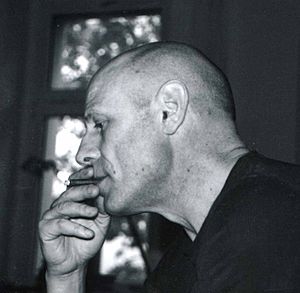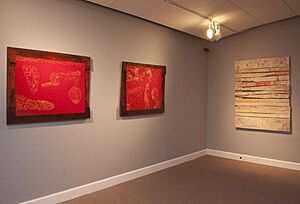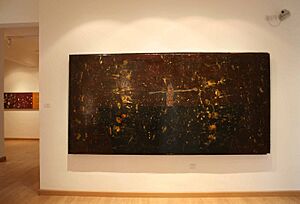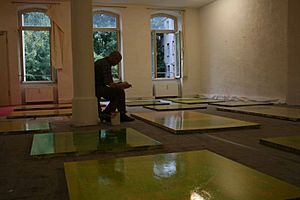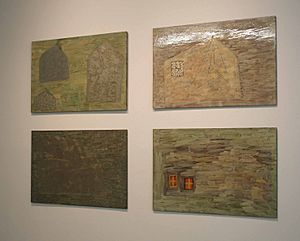Antón Lamazares facts for kids
Antón Lamazares (born in 1954) is a famous Spanish painter. He is known for being part of the "generation of the 80s" in art, along with other important artists like José María Sicilia and Miquel Barceló. Lamazares uses special ways of working with wood and cardboard, adding varnish and other materials to create his unique art.
His style has changed over time. At first, his art was playful and full of expression. Later, it became more abstract, focusing on feelings and ideas rather than clear pictures. More recently, his art has become simpler, almost like minimalism, where he explores deep feelings, memories, and dreams. His artworks have been shown all over the world and are kept in many important places, including the National Museum Reina Sofía in Spain and the Marugame Hirai Museum in Japan.
Contents
Biography
Early Life: Art and Words
(Galicia, 1954–1977)
Antón Lamazares was born on January 2, 1954, in a small village called Maceira in Spain. Growing up in the countryside had a big impact on his art and how he created things. From 1963 to 1969, he went to a special school where he studied literature, especially old Latin and Greek stories.
In the late 1960s, he started writing poetry. He also became friends with famous people like the writer Álvaro Cunqueiro and painters Laxeiro and Manuel Pesqueira. These friends helped shape his artistic journey. As he started to love painting more than poetry, he traveled across Europe in 1972. He wanted to see the works of great artists like Paul Klee, Rembrandt, and Joan Miró in person. He also admired Antoni Tàpies, Manuel Millares, Alberto Giacometti, and Francis Bacon, as well as ancient art from the Middle Ages and Oceania.
After his travels, he briefly stayed in Barcelona. He worked in construction but spent his free time visiting museums, especially to see the old Romanesque art. Next, he moved to Madrid, where he reconnected with his teacher Laxeiro. He also met the poet Carlos Oroza, and their friendship became very important to him. The connection between painting and poetry is a key part of all his work.
By 1973, when he was just 19, Lamazares was already showing his paintings in art shows. In 1975, he joined the Navy for his military service. During this time, he heard some very sad news about events in Spain, which made him feel very down. He wrote a collection of poems called Adibal during this difficult period.
"Throughout the 20th century painters have wanted to express the most hidden and mysterious places of the human being. But when they did so, it has always been on a white canvas, as if they had the ability to express themselves over the immaculate territory of nothingness. For me a painter isn't someone who demonstrates his power over a surface, but one who succeeds in establishing a relationship of conflict and of respect with the world that surrounds him. When I take up a piece of cardboard or wood and paint on it, I do so because I believe that I am thereby calling to mind the importance of a sacred dimension."
From Expressive Art to Two-Sided Paintings
(Madrid-New York, 1978–1989)
In 1978, Lamazares moved to Madrid. There, he became good friends with painter Alfonso Fraile, art dealer Juana Mordó, art critic Santiago Amón, and neurologist Alberto Portera. Many artists, writers, filmmakers, musicians, and painters would meet at Portera's country house. In 1979, Lamazares even held an outdoor art show there. That same year, he met Joan Miró and traveled through Provence to see the landscapes that inspired artists like Van Gogh and Picasso.
The 1980s were a very busy time for Lamazares. He created a lot of art, and his work became widely known. By the time he was 30, he was already a recognized artist in Spain and around the world. His paintings from this period were colorful and imaginative, showing playful and dreamlike figures. He had exhibitions in important galleries in Madrid, Belgium, and Barcelona.
Soon after, he moved to New York City for two years with a special scholarship. There, his painting style became simpler and more focused on the materials he used. He showed his art at the Bruno Fachetti Gallery. For a while, he split his time between New York and Salamanca, Spain. In 1988, he traveled through Anatolia and Istanbul, where he was very impressed by the old Byzantine churches. You can see these experiences reflected in his art from that time, especially in how he arranged wood in his paintings. In 1990, he started making a new series of works that could be viewed from both sides, which he called bifrontes (meaning "two-sided").
Sculptural Art and Big Paintings
(Paris-Madrid, 1990–2003)
In 1990 and 1991, Lamazares lived in Paris with a grant. In 1991, he opened a large studio in Madrid. There, he started working on two series of paintings called Gracias vagabundas (Wandering Graces) and Desazón de vagabundos (The Anxiety of Vagabonds). In 1993, he met the famous artist Antoni Tàpies and later published a long interview with him.
From May to November 1996, he worked in Galicia, Spain, painting a series called Gracias do lugar: Eidos de Rosalía, Eidos de Bama (The place's charm: Rosalía's fields, Bama’s fields). From June to November 1997, he painted outdoors for his series Bés de Santa Baia. That same year, he met the sculptor Jorge Oteiza, and their long conversation was even filmed. In 1998, in Madrid, he painted Titania e Brao, which was a tribute to the summer in Castile, and then Pol en Adelán.
During this time, he also created many graphic works, like etchings for a book called El Canto de la Cabeza and lithographs for Itinerarium. His work was chosen by the Spanish Ministry of Foreign Affairs to be promoted internationally, alongside other important Spanish artists. Around this time, Lamazares traveled to Florence and Assisi in Italy to study Renaissance art and learn about Saint Francis. He dedicated a new series of paintings, Follente Bemil, to Saint Francis. In 2001, he had a large exhibition at the Seaport of A Coruña, called Un saco de pan duro (A Bag of Hard Bread).
From Abstract Art to Poetic Minimalism
(Berlin, since 2004)
In 2004, Lamazares moved to Berlin, Germany, where he still lives. After his father passed away, he started a series called E fai frío no lume (It’s Cold in the Fire). He had big exhibitions in Slovenia and Hungary.
Later, he worked on the series Domus Omnia and helped create two more artist's books with the poet Carlos Oroza. In 2008, he showed his work Horizonte sin dueño (Unowned Horizon) in the National Gallery of Jordan. He also had an exhibition of his graphic art in the Cervantes Institute in Syria, where a poet dedicated a collection of poems to him.
In 2009, he exhibited his work at the Queen Sofía Spanish Institute in New York and in Ourense, Spain. He also took part in an exhibition about the poet Vicente Aleixandre and received the Laxeiro Prize for his important work and international fame. In 2010, he showed his art in Santiago de Compostela and Tui, Spain. A documentary film called Horizonte sin dueño, which explores his art, poetry, and connection to nature, was shown at a film festival in Tui.
On May 20, 2010, the University of Santiago de Compostela gave him its Insignia de Oro (Golden Shield). This was a very special honor, as it was the first time in six centuries that an artist received it. On June 28, 2010, the Xunta de Galicia awarded him the Medalla Castelao. This award recognized the beauty and meaning of his artworks, showing his dedication to culture, history, and the spirit of his people.
See also
 In Spanish: Antón Lamazares para niños
In Spanish: Antón Lamazares para niños
- Abstract art
- Expressionism
- Minimalism
- Contemporary art
- List of Spanish painters


